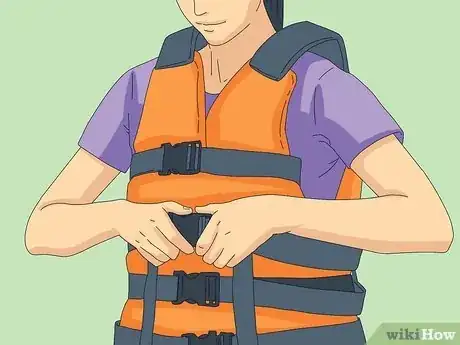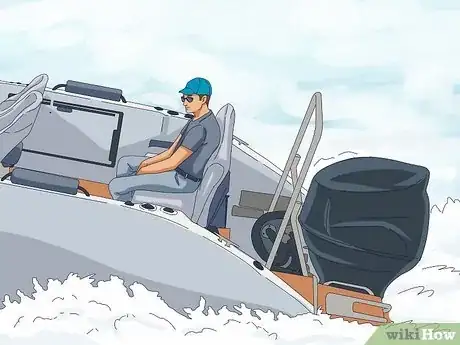This article was co-authored by Travis Lund and by wikiHow staff writer, Eric McClure. Travis Lund is the General Manager at the Vallejo Marina, a large marina located between the San Francisco Bay and the Delta in California. Sailing since he was six-years-old, Travis has over 15 years working in sailing operations and instruction and has pioneered a coaching platform that combined traditional coaching with multi-camera video support. He studied English at Michigan State University, where he was on the sailing team.
There are 7 references cited in this article, which can be found at the bottom of the page.
Capsizing, where a boat flips over and becomes inoperable, is one of the most dangerous emergencies you can encounter on the water. That’s why it’s so important to know what to do if the worst actually happens. It’s important to note, so long as you take the proper precautions before getting on the boat and know what to do if your boat does flip over, you’ll be okay. In this article, we’ll walk you through everything you need to do if your boat capsizes. We’ll also break down how you can prevent such an emergency in the first place. Read on to learn everything you need to do (and know) before taking your boat out.
Things You Should Know
- Stay calm, put on a life jacket, do a headcount, and signal for help with whatever means you have available.
- Keep everyone together and stay with the boat unless you’re absolutely positive you can reach the shore. A capsized boat will still float if it isn’t damaged.
- Avoid capsizing by staying seated in the boat, operating your boat responsibly, and tackling strong waves head on.
Steps
Surviving a Capsize
-
1Put on your life vests if they aren’t already on and you have time. Clip the vest in place and pull on the hanging strips to tighten the jacket and secure it. If you don’t have time to put a life vest on or you don’t know how to wear it in the moment, just grab a life jacket and hold on to it. Even holding a life vest will help you stay afloat in the water.[1]
- The life vest should be snug and tight, but not so tight that you can’t breathe comfortably.
- If you’re going out on the water, always keep your life vest on at all times.
-
2Hit the emergency signal transmitter if you have one. If you’re on a boat bigger than a canoe or kayak, you may have a VHF marine radio or emergency transponder. If you do, hit the button labelled “distress,” “mayday,” or “DSC” (it will almost always be red) to alert nearby emergency services. This is the boating equivalent of calling 911, so someone will come to help ASAP.[2]
- If you have time, put out a mayday call by tuning to the most active channel and calling out “Mayday, mayday” followed by your GPS coordinates or position.
- If you have an emergency transponder (Emergency Position Indicating Radio Beacon, or EPIRB), just turn it on. It automatically calls for help.[3]
Advertisement -
3Blow the whistle or honk your ship’s horn. If your boat has an emergency kit, grab the whistle and put it around your neck. If the ship is going down and there are other boats around, blow the whistle as hard as you can. If you’re on a motorboat or larger pontoon with a horn, blow that instead.[4]
- Once you’re in the water, blow the horn whenever you think someone may be able to hear you. A whistle in the water is a universal sign of distress.
- Light a distress signal or flare if you have one. You can do this before your boat capsizes if you have time, but you may need to do it in the water.[5]
-
4Take a headcount to make sure nobody is missing. Once you’re in the water and you’ve oriented yourself, confirm that everyone on the boat is in the water. This way, you can identify if anybody needs help. If someone has gone overboard far from where the rest of you are, tell them to swim to you. If you can throw a survival ring to them, do that.[6]
- If there are other people on the boat with you, do not split up or send someone to swim for help.
-
5Stick with the boat unless you can push it to shore. A flipped over canoe, kayak, or other small boat will continue to float so long as it isn’t damaged. It might bob right below the surface of the water, but it won’t sink. Stay with your boat to prevent drowning and don’t try to swim to shore. If the water is calm, slowly kick or paddle the boat towards shore.[7]
- Unless you are absolutely 100% positive that you can swim to shore, don’t abandon your boat. Even if you can see the shore, you’d be surprised how quickly you get exhausted. On top of that, you never know when a current will pull you further out from shore.
- If you’re in a river, don’t fight the current. Stay with the boat and orient yourself so your body is opposite to the nearest shore. This way, you won’t get pinned against a rock.
-
6Assume the HELP position if you’re stuck in open water. The biggest risk in open water is hypothermia. Retain your body heat and stay afloat by getting into the Heat Escape Lessening Posture (HELP position). Tuck your chin down, cross your arms across your chest, cross your legs, and pull your knees up while tilting back a little. You’ll float just fine and stay warmer for longer.[8]
- If you can hold on to your boat, do that instead.
- If there’s debris or some other item that’s floating in the water that will help you stay above the water, go ahead and grab that.
-
7Make noise if you can see another boat. As soon as someone may be within earshot, let some yells out and wave your arms. Do whatever you can to signal that you need help. It can be exceptionally difficult to see a capsized boat or people in the water when there are even minor waves, so the more movement and noise you can generate, the more likely they’ll spot you.[9]
-
8Wait for help to arrive and encourage everyone to stay calm. Don’t get stressed out and remain patient. Keep everyone’s spirits up. So long as you stay with your boat and continue to help people find you by making noise and staying visible, someone will show up to help. It can be scary, but just know that you are extremely likely to be rescued.[10]
- Unless your boat is in the middle of nowhere, it’s actually extremely rare for a capsize to result in anyone’s death or serious injury if everyone stays with the boat.
Preventing a Capsize
-
1Check the weather report before you go out. Never take a boat out on the water if there’s going to be a storm. To avoid running into a random storm on the water when you’re nowhere near shore, check the shore reports and pull the expected weather to confirm that it’s going to be safe on the water.[11]
- If you are on the water and you see storm clouds forming, head for shore immediately.
-
2Bring waterproof sealant on the boat with you. Waterproof sealant is designed to cure and harden in water, which is helpful if your boat springs a leak. If your boat begins to leak and you don’t have a sealant on hand, you’ll risk capsizing and sinking. If you do have sealant though, you can apply it to any cracks or seams which will buy you enough time to get to shore.[12]
- If your boat does spring a leak on the water and you don’t have sealant, head towards shore, keep your life vest on, and call/signal for help if necessary.
-
3Go slow in rough water and keep a lookout for obstacles. An inexperienced or distracted captain is one of the most common risk factors in boat accidents. Be a responsible operator and don’t push your luck on the water. Slow down whenever you aren’t completely in control and keep your eyes out for dangers on the water.[13]
- Your knowledge of the boat should play a major role in how you operate it. If you don’t know the ins and outs of how easy your boat is to handle, always play it safe.
- Are you new to boating? If so, stay close to the shore and don’t take the boat out alone.
-
4Remain seated when you’re in a small boat. Standing up—even just to move a few feet or change your seat—will dramatically shift the boat’s center of gravity. This can cause rowboats, canoes, kayaks, or small pontoons to flip over at a moment’s notice. If you have to move, stay crouched, do it in still water, and let everyone in the boat know where you’re going so you can all adjust the weight distribution accordingly.[14]
- Follow the recommended load capacity of the boat and keep the weight distribution even if you’re carrying any cargo.
- 70% of all boating fatalities are the result of people going overboard on a small boat—either because they fell or the boat capsizes. As such, it’s extremely important to take any preventative steps you can to avoid a capsize.
-
5Anchor from the bow—never the stern. Anchoring off from the back of the boat (the bow) is one of the most common reasons newer skippers end up capsizing small boats. Boats are designed to be anchored by the bow most of the time (if it’s not the bow, it’s port or starboard). The bow is designed to stabilize the boat and keep any motor or propeller safe, so adding the additional weight of the anchor can cause the boat to flip over.[15]
- If there’s a little hoop or bracket near the front of your boat, that’s where you’re supposed to tie off the anchor.
-
6Take strong waves head on and never turn perpendicular. If you’re in a small boat and the waves are rough, turn your boat so that the waves are hitting your bow or stern head-on. If waves or strong currents hit your port or starboard side, they can knock your boat over and capsize it. This is an especially likely occurrence if you’re perfectly perpendicular with a wave, so tackle rough waters directly.[16]
- This is especially important when you’re in a smaller boat, which is more likely to be thrown over by a heavy wave.
- If the currents and waves are so strong that you feel like you could potentially lose control of your boat, it’s a big sign that it’s time to head for the nearest port.
References
- ↑ https://www.uscgboating.org/images/420.PDF
- ↑ https://www.ntsb.gov/investigations/AccidentReports/Reports/MAB1814.pdf
- ↑ https://www.uscgboating.org/images/420.PDF
- ↑ https://files.dnr.state.mn.us/rlp/regulations/boatwater/boatingguide.pdf
- ↑ https://www.uscgboating.org/images/420.PDF
- ↑ https://www.greenwichtime.com/local/article/Death-of-America-s-Cup-sailor-remains-unsolved-4641707.php
- ↑ https://www.fs.usda.gov/detail/r8/recreation/safety-ethics/?cid=fsbdev3_066382
- ↑ https://www.uscgboating.org/images/420.PDF
- ↑ https://www.fs.usda.gov/detail/r8/recreation/safety-ethics/?cid=fsbdev3_066382
- ↑ https://www.fs.usda.gov/detail/r8/recreation/safety-ethics/?cid=fsbdev3_066382
- ↑ https://files.dnr.state.mn.us/rlp/regulations/boatwater/boatingguide.pdf
- ↑ https://www.boatlife.com/boatlife-blog/sprung-a-boat-leak-here-are-three-steps-to-avoid-disaster/
- ↑ https://files.dnr.state.mn.us/rlp/regulations/boatwater/boatingguide.pdf
- ↑ https://www.uscgboating.org/images/420.PDF
- ↑ https://www.uscgboating.org/images/420.PDF
- ↑ https://www.boatingmag.com/what-to-do-when-rogue-wave-heads-for-your-boat/













































